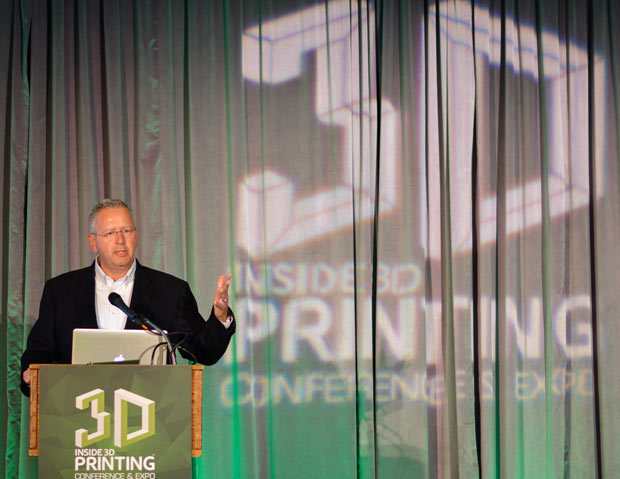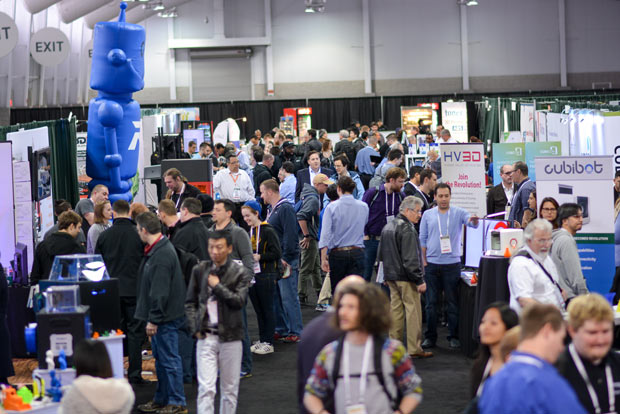3D Printing: What’s Next?

Latest News
April 21, 2016
 Inside 3D Printing NY attendees browse the show floor for new technology and systems. Image courtesy of Steve Hall.
Inside 3D Printing NY attendees browse the show floor for new technology and systems. Image courtesy of Steve Hall.With any technology, engineers are always finding ways to expand its uses, accessibility and make enhancements. This was the sentiment at the Inside 3D Printing NY show as attendees gathered in the Javits Center from April 10 to 12 to discuss the general state of additive manufacturing, its applications and what lies ahead. “Investment [in 3D printing] hasn’t been anything like it has been in the [past] 20 years in the industry. It’s continually growing,” said Terry Wohlers, president of Wohlers Associates, during his overview of the market.
Industries are still finding uses for the technology and investigating its benefits. If you look, you’ll find examples of serious production using 3D printing that started with the medical and dental industries, but is growing into the aerospace, consumer product and automotive sectors, according to Wohlers. He said Airbus is one example of additive manufacturing adoption, and the company is on course to be producing over 30 tons of metal AM per month by December 2018.
Overall, Wohlers noted, additive manufacturing is expected grow to be a $25.6 billion market by 2021. “[Currently], growth is strong in desktop systems and metals. There’s lots of startups, investments and development,” he said.
Appification of 3D Printing?
3D printing companies are still finding new ways to encourage adoption. For consumers, this means providing software and hardware that is easy to use and requires minimal setup. Vendors are also finding ways to get developers and engineers on board — through apps. During his presentation, MakerBot CEO Jonathan Jaglom announced the MakerBot Thingiverse Developer Program, which lets community users create their own applications for 3D printing services, customization and modification. The company has already announced apps for 3D Hubs and Make Printable.
Jaglom: Integration between @makerbot, @3DHubs and @MakePrintable will help users fix models and print designs from Thingiverse #I3DPConf
— Desktop Engineering (@DEeditor) April 11, 2016
“We invite all developers to tap into the Thingiverse community and tap into their best practices for [a] print, customization or file fixing. Whatever they think that they can provide to Thingiverse and offer solutions to our customer base,” Jaglom said. “This is what the world of tomorrow is going to look like.”
MakerBot isn't alone in offering 3D printing apps for the web, but this may be one of the first where users can create their own app for their individual 3D printing needs. Beyond this program, users can find a host of design applications for their smartphone or tablet by searching online or seeing if their 3D printing system has one. The easy accessibility of these applications might get more people interested in the technology and further increase adoption. “MakerBot is all about providing accessible tools for 3D printing,” said Jaglom, and this application model might just be one way to start.
A Manufacturing Shift
In addition to new product releases and announcements, attendees also debated one of the main questions surrounding 3D printing: Will the technology replace traditional manufacturing? Additive manufacturing may not become the mainstream for many more years to come, but that doesn’t mean manufacturing is stagnant. 3D printing is finding its place within the manufacturing and product design industries.
Addressing this need for 3D printing, Peter Weijmarshausen, CEO of Shapeways, discussed the development of digital manufacturing and how printing systems offer a way to alter the landscape of manufacturing. “The next wave of new technology is machines that we can use make things, but they make it in a different way,” he said. “This is the difference between mass manufacturing, which is an analog technology, and machines that can basically make any type of product. We’re now starting to understand that these machines have capabilities that might enable us to transform manufacturing to a digital technology.”
The idea of digital manufacturing, according to Weijmarshausen, changes who can make designs, what is made and where it’s made. With 3D printers, end users now have access to the products they want by printing them, and manufacturers don’t have to take the cost risks of mass-producing something for which there is no market.
However, experts are still investigating how to address the gap between prototyping and full-scale production with 3D printing. “There is a mutual exclusivity between the benefits of 3D printing and manufacturing, which hinders adoption,” said Joseph DeSimone, CEO of Carbon. His company is working to address this by launching the new M1 system, which uses the CLIP (Continuous Liquid Interface Production) method. The proprietary system may be ushering in a new wave of rapid 3D printing, as well as a new pricing scheme for 3D printing systems.
The M1 will be sold on a subscription basis. The annual subscription will cost $40,000 per year, and includes a service team that uses operational data collected by the connected 3D printer to deliver predictive service and machine updates.
“The M1 is the kind of tool you expect for an Internet of Things world and manufacturing. Everything is software tunable,” DeSimone said. Partnerships are also key for adoption, and DeSimone said Carbon is working to establish machine aggregates with service bureaus to offer manufacturing options.
 Joseph DeSimone, CEO of Carbon, discusses recent technology developments from his company. Image courtesy of Steve Hall.
Joseph DeSimone, CEO of Carbon, discusses recent technology developments from his company. Image courtesy of Steve Hall.While the investment is heavy in additive manufacturing, presenters and attendees still feel the technology has a ways to go before it becomes the main product development standard. “I think we’re in the early days. However, we’ve learned that change has been moving faster, so it could be within the next 5 to 10 years the amount of products made with 3D printing [is closer to] the amount of products made with traditional manufacturing. But what is needed for that is a few things, including the right materials that people recognize and like, the right content, the right prices, turnaround time and quality,” says Weijmarshausen.
Subscribe to our FREE magazine, FREE email newsletters or both!
Latest News
About the Author
Jess Lulka is a former associate editor for Digital Engineering. Contact her via [email protected].
Follow DE





